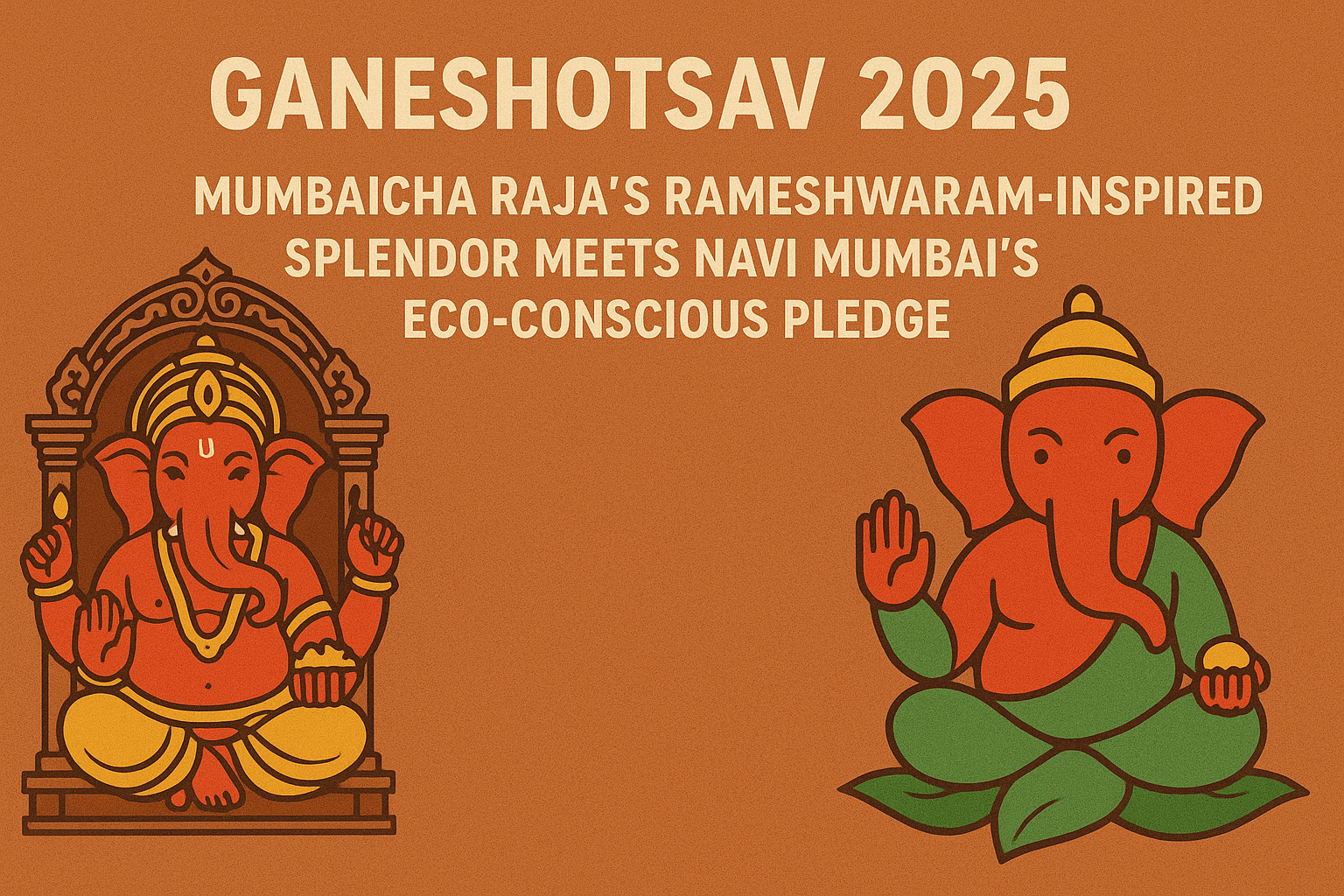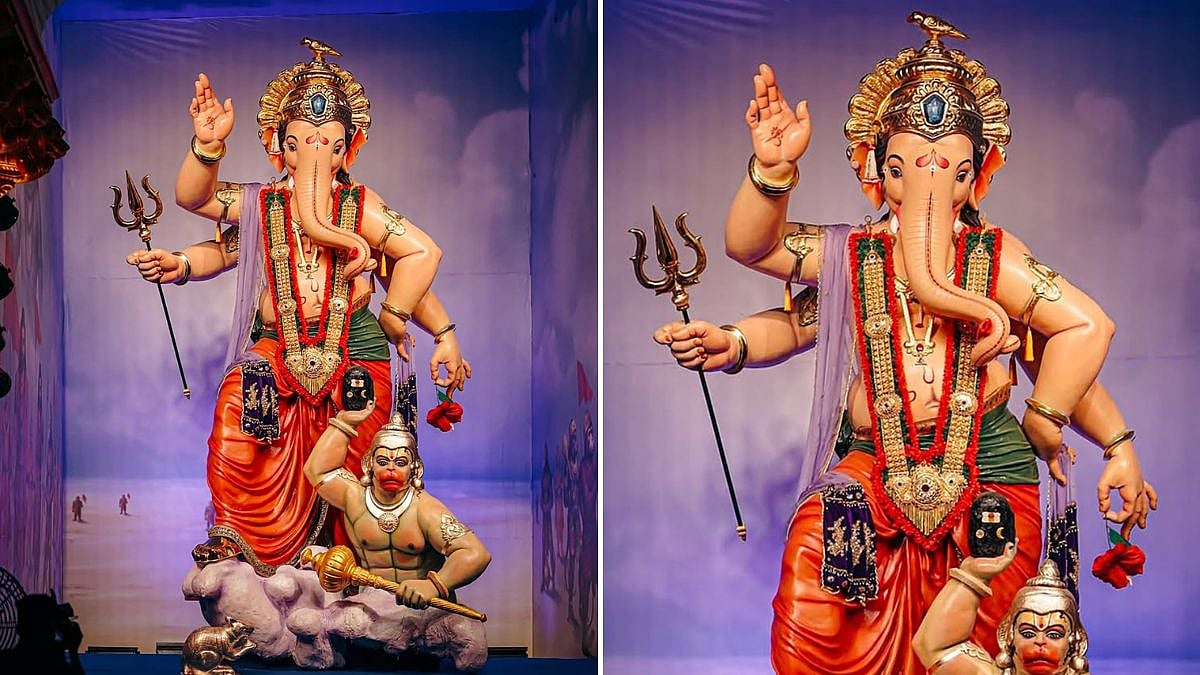
Ganeshotsav 2025: Mumbaicha Raja’s Rameshwaram-Inspired Splendor Meets Navi Mumbai’s Eco-Conscious Pledge
Mumbai is a city that never sleeps, but once a year it does pause — not for silence, but for the rhythm of drums, chants of Ganpati Bappa Morya, and the collective heartbeat of millions. Ganeshotsav 2025 has begun to unfurl its magic, and this year, it carries both grandeur and responsibility in equal measure.
On Monday, the much-awaited first look of Mumbaicha Raja 2025 was unveiled by the Mumbaicha Raja Sarvajanik Ganeshotsav Mandal. Celebrating its 98th year, the mandal has chosen the Rameshwaram Temple of Tamil Nadu as the central theme — a choice that merges Mumbai’s spirit with India’s civilizational depth.
For devotees, this is more than decoration. It is an architectural homage that transforms a neighborhood into a temple complex, reminding us that religion in India is rarely just about ritual; it is about storytelling, design, and connecting generations. The sight of Lord Ganesha against this stunning backdrop is expected to draw lakhs of visitors in the ten days of celebration.

The King of Mumbai
Mumbaicha Raja is not merely an idol; it is a civic institution. Revered as the ‘King of Mumbai’, it attracts crowds rivaling sporting events or political rallies. But unlike those arenas of division, here, unity is the theme. Strangers stand shoulder to shoulder, waiting hours for a glimpse of the idol, exchanging food, songs, and stories.
This year, as Mumbai gears up for celebrations beginning August 27, Mumbaicha Raja will once again reaffirm what the city already knows: that festivals in India are both a spiritual anchor and an economic multiplier. Thousands of artisans, decorators, musicians, vendors, and small businesses thrive during these ten days. Faith, it seems, is also a form of employment.
A Tale of Two Cities: Faith Meets Responsibility
While Mumbai dazzles in grandeur, Navi Mumbai Municipal Corporation (NMMC) is scripting a quieter but equally significant story. Determined to make Ganeshotsav eco-friendly and plastic-free, the civic body has created 143 artificial ponds across the city for idol immersions.
This is not just about compliance with court orders that require idols up to six feet to be immersed only in artificial ponds. It is about leadership. For years, environmentalists have warned against the impact of Plaster of Paris idols and toxic chemical paints on rivers and seas. NMMC’s efforts signal a shift: devotion must now align with sustainability.
Clay Over Plaster, Cloth Over Plastic
The corporation has urged citizens to adopt shadu (clay) idols instead of Plaster of Paris. It has encouraged mandals and households to avoid thermocol and plastic decorations, replacing them with cloth, paper, or other reusable materials. Noise levels are to be kept within permissible limits, and the use of blaring laser lights discouraged.
What emerges is not a clash between tradition and modernity, but a conversation. Can faith celebrate without polluting? Can devotion be grand without being destructive? NMMC’s answer is a confident yes.
The Economics of Faith
Behind these initiatives is a deeper truth: festivals are not just about spirituality. They are about economics, employment, and environment. Ganeshotsav fuels micro-economies — from flower sellers to transport operators, sweet makers to artisans. But without sustainable practices, this economic boost comes at a cost to rivers, beaches, and marine life.
By mandating artificial ponds and promoting clay idols, NMMC is showing that India’s biggest strength is not choosing between tradition and progress, but weaving them together.
Faith for the Future
As the first look of Mumbaicha Raja draws gasps of admiration, and as Navi Mumbai prepares its eco-ponds, the larger narrative of Ganeshotsav 2025 is clear. It is a story of balance — between devotion and duty, between spectacle and sustainability, between Mumbai’s grandeur and Navi Mumbai’s governance.
Lord Ganesha, after all, is the remover of obstacles. This year, perhaps his biggest blessing to Mumbai will not just be prosperity, but also a reminder that faith and environment can, and must, coexist.





